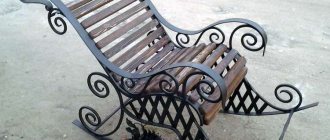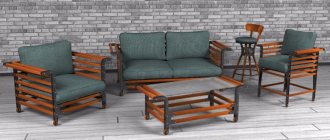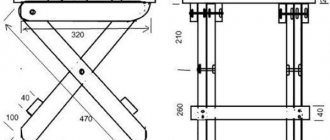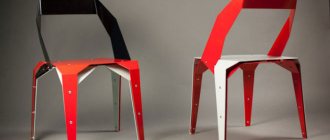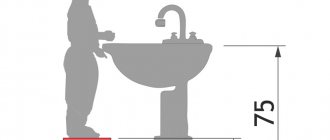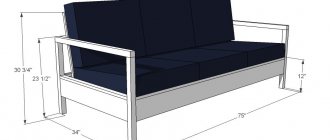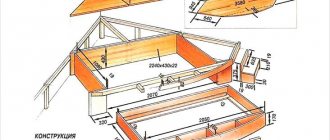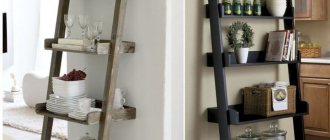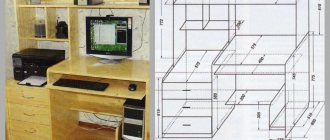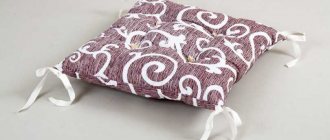Metal seating furniture has always had two main advantages. Firstly, it practically does not break and can withstand the most extreme loads, serving faithfully for several decades. Making chairs from a metal pipe is quite accessible even for a novice craftsman; you just need to choose the right material, know how to use the tool and choose the most interesting model.
Chairs made of metal pipes, assembled without welding, their reliability is approximately three times less than welded structures
Features of making chairs from pipes
If you choose a suitable material for manufacturing, it is best to make chairs from a 20 by 20 mm profile pipe. The wall thickness of this profile is 1-1.5 mm, resulting in a durable and not too heavy structure.
On the other hand, the use of a thin-walled metal pipe entails additional difficulties:
- Due to the small thickness of the walls, it will be necessary to use carbon dioxide or plasma welding; moreover, before attempting to make chairs from pipe, some practice in making welding seams will be required;
- You will need to assemble individual parts into a finished frame using clamps or any other similar tool;
- In addition to the profile metal pipe, you will need at least steel corners, bolts, nuts, fasteners, everything that will be needed to install the seat, armrests and backrest.
Advice!
It is clear that in this case, seating furniture is made not for the garage, but for the interior of an apartment or house. You always want to make your design more attractive and stylish, so if possible, when choosing a suitable model, it is advisable to abandon straight angular shapes and transitions. Without any problems, you can bend only a seamless metal pipe. Chairs made from round pipes are considered the most difficult to manufacture.
It is well known from practice that a misaligned connection of round profiles is not always strong enough, so it is necessary to additionally use mechanical fasteners - bolts and nuts. Therefore, if possible, it is better to use a rounded profile, rectangular or square, in this case the design at least will not be spoiled by protruding nuts.
I add polish: I sand and paint
On Sunday morning I started finishing the stool. I drilled holes for the screws that will hold the seat.
A hole with a diameter of 5 mm for a self-tapping screw that will connect the “picture” to the iron. Photo by the author
I cleaned up a few rust spots on the pipes. I thoroughly wiped the structure with a rag and degreaser.
The screwdriver attachment with sandpaper is excellent for removing rust. Photo by the author
I had aerosol primer-enamel for rust 4 in 1 from VIXEN. It combines the properties of primer, anti-corrosion coating, decorative enamel and protective varnish. There was one bad thing - the instructions stated that they should be painted at a temperature of +15 to +30°C, but, as luck would have it, it was only +14°C outside.
Aerosol for painting in perfect black color. Photo by the author
According to the instructions, I shook the container thoroughly. The first coat of paint went on smoothly. I was happy with the result, because it’s impossible to get such an even coating with a brush—smudges still remain. But I had to put the “chassis” on the stove to dry, because a rain storm started outside, and the temperature dropped to +10°C.
I painted it outside. One minus is that the breeze blows away the stream. Photo by the author
The next day I painted the base and legs again and realized that two coats was enough. Since paint also replaces primer, anti-corrosion coating and protective varnish, it turned out that I spent 3 times less time on paintwork! Yes, and I saved money, to be honest. In addition, this coating is weather-resistant, which means you can safely use the stool outdoors - it will not be afraid of rain, humidity, or frost.
What is needed to make a chair from a profile pipe
The process of making furniture with a steel frame based on a square or rectangular profile is nothing complicated or unusual; most operations are familiar to anyone who likes to do metalwork or garage DIY.
You won’t be able to make an elegantly designed chair without a pipe bender.
To work you will need:
- Semi-automatic welding. The equipment is quite heavy, so there is no point in even renting it in order to weld homemade folding chairs from a profile pipe. You can always come to a car service center or a locksmith shop, where they will do the work for a small fee;
- Angle machine - grinder with cutting wheels for metal;
- A set of clamps or stable holders, with their help they fix individual pieces of metal before welding the seams;
- A sharpener with a “rough” stone for removing burrs;
- Electric drill with a set of drills;
- A bending machine or press, on which you will need to bend the blanks into curved shapes before cutting the pipe and joining it by welding. Typically this device weighs 10-15 kg, so the machine can be rented or borrowed from friends for a couple of days.
For your information! It is considered the most difficult to impart the necessary curvature and profiling in the case of a round pipe.
Typically, the first attempts to roll a round pipe into a curved section result in substandard spirals and oblique arcs. Therefore, it is best to make small sections from a round profile that can be easily aligned and adjusted to size.
Working with a semi-automatic welding machine is quite simple, you just need to practice connecting different types of pipes, this will take a maximum of a few hours before the mode and gas consumption are selected. An alternative to a semi-automatic machine can be an inverter welding machine. It also allows you to weld seams with fairly high quality, but working with such equipment requires very good electrodes and some experience of the welder.
Final finishing
The assembled table with your own hands must be treated with protective agents. Antiseptics are used to prevent the negative effects of moisture. As for finishing materials, safe water-based acrylic varnishes are most widely used today. The tabletop is made from a variety of materials: wood, metal, plastic, glass. By themselves, these options look quite attractive, but require special processing. Wooden countertops are carefully sanded and at least 3 layers of paint or varnish are applied to obtain a mirror-smooth surface. Glass and plastic usually do not require additional processing; metal products look great in tandem with forged elements.
A table made of metal with a tabletop decorated with mosaics, paintings, and glazing looks attractive. Increasingly, furniture is decorated using decoupage techniques. To apply a neat design to the surface, all kinds of stencils are used.
A table made of metal and wood is characterized by strength, reliability, and durability. The stylish design will decorate residential premises or summer cottages. The models are successfully used for plumbing work, friendly gatherings, and family dinners.
Drawings of chairs from profile pipes
As an example of the effective use of the capabilities of a steel frame, here is a small drawing of a bar stool.
This design has its own characteristics:
- The rear legs are inclined at an angle of 15° from the vertical, this provides good stability for an unusually high seating position;
- The front legs are narrowed, but at the same time they have a divergence at an angle of up to 20° in the lower part of the structure;
- The presence of a horizontal crossbar at a height of 30 cm makes the chair more comfortable, since the remaining 50 cm allows you to easily place your feet on the stand.
The design has a high center of gravity, so bar stools and chairs must be handled with extreme caution; the metal frame can injure your feet if dropped.
Round profile chair option
If you need an absolutely safe version of a stool made from a profiled pipe, then you can use the diagram shown in the photo below.
The appearance and design of the furniture is clearly outdated, but it turns out very durable and reliable
Chair option for home workshop
The design is slightly higher than the 50 cm standard, but this fit is most convenient in a situation where you have to work at a table or at a workbench. The simple square tube frame construction provides tremendous strength. Craftsmen love such chairs because, if necessary, they can always be used as a stand or portable table.
Another example, this time a universal-purpose chair made from a profile pipe. The diagram was spotted at a sports simulator for exercising with a barbell. Such a project attracted the attention of summer residents and lovers of country holidays.
The presence of an additional element on the back side makes the chair very convenient when processing crops, and the durable and rigid frame made of a 40x40 mm square metal pipe guarantees a service life of at least 20 years, even in summer cottage conditions.
For your information! When planning a specific design scheme for a chair, it is necessary to take into account the restrictions imposed on the minimum bending radius, so that the pipe does not deform or bend during rolling with a roller; it would be correct to perform an approximate calculation in advance regarding the conditions of critical deformation.
General requirements are shown in the diagram below.
Choice of design and construction
Having opened any catalog of bar furniture, it is simply unrealistic to immediately stop your gaze on a specific model, because the variety of shapes and colors is amazing. However, it is not always possible to find something suitable for your interior. In this case, it is worth making the furniture yourself. When making bar stools, it is necessary to take into account a number of important parameters.
Properly calculated chair height is the key to comfort. The optimal distance from the seat to the bar counter is 25-30 centimeters. The presence of such space provides comfort and freedom of movement.
The large surface area of the furniture promotes relaxation and immersion in an atmosphere of comfort. However, not every bar table can allow a wide range. When thinking about making a chair yourself, you need to calculate the dimensions of the seat based on the width and depth of the tabletop. It is desirable that during operation there is no interference within a radius of 20 centimeters. This will provide comfort without violating the personal space of the person sitting at the bar counter.
When developing a chair design, it is necessary to consider the following components:
- Base. Of course, everyone's preferences are different, but experts recommend using four legs. They will give the bar stool maximum stability and reliability. It would be useful to think about the possibility of adjusting the height, provided that among family members, relatives, and acquaintances there are people of different heights.
- Back. For snacks or other short-term use of stool, this parameter is not particularly important. If you plan to sit for a long period of time, then it would be reasonable to opt for a high, well-fixed backrest, on which you can lean back at any time.
- Armrests. This design element is voluntary. There are no special recommendations. It all depends on personal preference.
- Upholstery. Its presence is due to the prioritization between style and comfort. Hard chair seats made of metal, acrylic, plastic, wood look more stylish, fitting perfectly into a modern interior. Soft models, covered with fabric or leather, are pleasant to the touch and more comfortable.
When choosing a design, the decisive factor is the overall interior of the room. Traditional furniture, for example, will not look entirely appropriate in a room decorated in high-tech, bionic or brutalist styles. A bar stool made by yourself should fit harmoniously into the design of the room and not stand out from the overall picture.
It is better to choose the colors of the furniture based on the overall color scheme of the room. This is especially important for the foundation. But as for the seat of the chair, it is recommended to give free rein to your imagination. You can choose options ranging from solid colors to floral or animal prints. Then the bar stool will become a bright highlight in the interior.
How to make a chair from a profile pipe
The most difficult element of preparation is the correct bending of individual sections of pipe. The fact is that a hollow metal profile, when processed by a roller press, is easily deformed, causing waves and splashes to appear on the surface. Therefore, when choosing a chair model, it is best to give preference to those projects that do not involve bending along a too small radius.
Chair made of chrome pipe
The presence of a decorative coating of chrome or nickel significantly improves the appearance of homemade furniture made from a metal pipe. On the other hand, when trying to bend a pipe, the chrome easily peels off from the copper underlayer applied to the ferrous metal.
Chairs from a ready-made set of chrome-plated parts are assembled with one screwdriver and saw
The simplest option is to make chairs from round or profiled pipe without bends. In this case, all connections between parts are made using internal threaded plugs and studs. A round furniture tube is best suited; it is easy to assemble the simplest version of a chair or stool from it, approximately the same as in the photo.
The second option involves using a metal pipe without a chrome coating; such material can be bent to the desired radius without any problems using a manual pipe bender. Before assembly, the chair parts will need to be subjected to galvanic chrome plating.
A thin-walled metal pipe can be bent with a hand tool
To make it you will need to bend it with a pipe bender:
- Back with hind legs;
- U-shaped frame of the front legs;
- A ring that enhances the rigidity of the entire structure.
It is clear that all the parts will have to be connected using semi-automatic welding. The seat is made of a plywood circle, covered with foam rubber and upholstery fabric, and then attached to a metal pipe using ordinary self-tapping screws.
Flat oval tube chair
The material is a metal profile of oval cross-section. As a rule, such a pipe has a seam located on one of the flat surfaces. The material can be painted or have a galvanic coating based on nickel and chromium. The wall thickness of a flat-oval pipe usually does not exceed 0.5-1.0 mm, so bending such a profile is extremely difficult even with the appropriate equipment. The bending radius for a standard pipe for making chairs should not exceed 12-15 cm.
The chrome-plated metal profile is very capricious in processing
If you are trying to make a homemade chair from a flat-oval pipe, then it is best to use a standard version of office furniture as a prototype, as in the photo.
To make the simplest model, you will need to bend the U-shaped frames for the legs. The backrest will have to be bent twice, the first time in order to form a supporting profile, the second time to ensure an angle of 120° between the horizon of the seat base and the plane of support for the back.
Square tube chair
It should be noted right away that any furniture assembled from a metal square profile does not have the most outstanding design. Office furniture, stands, frames for workbenches and work tables are most often made from square pipe.
The most popular model made of square metal profile
An example of how to successfully use all the advantages of a square profile is this diagram of a school chair with an adjustable seat height.
Despite the simplified design, the metal pipe chair turned out to be incredibly durable, unpretentious and easy to make with your own hands. To assemble, you will need to bend two arcs from a square pipe under the seats and backrest.
The legs are made from two sizes of square profile, the lower part is welded in the form of two T-shaped supports with a horizontal jumper. Between the seat and the legs you will need to install a transition piece made of two pieces of metal pipe with a side of 15 mm.
Bent pipe chair
Structures made from bent profiles are distinguished by a very impressive design, distinct style and laconic forms. The process of making such a chair with your own hands involves creating a frame from one uncut piece of metal pipe.
For example, to make the simplest model of two chairs shown below, on average, at least 3.5 m of thin-walled metal pipe with a diameter of 25 mm was required.
Most of the frame of the central arch and legs are bent on a machine; the transition zones in the area of the seat and back often have to be made using a manual pipe bender. If you plan to make a full-fledged chair from a bent metal pipe, then it is best to choose models of a simpler design, or use projects with rectangular inserts.
Stool made of profile pipe
Of all the designs and designs for metal seating furniture, making a stool can be considered the best option for your first attempt. The structures are very simple, and most often can be assembled even from the remains of a profile pipe after making a workbench or rack.
Almost always, the basis of a stool is a rectangular frame made of a square or round pipe, welded in a pyramid or in the usual direct way. A plywood sheet covered with polyurethane foam and leatherette is most often used as a seat.
Bar stool made of profile pipe
Most metal chairs and stools are made in the form factor of bar furniture. The demand for similar products made from profiled pipes is quite high, so many models and schemes have been invented, usually from a square profile with a wooden seat.
The main material for the chair is a square metal profile
The design and methods of manufacturing such a chair are no different from the previously mentioned stool made from a metal pipe. The only significant difference is the high seating position at approximately 80-85 cm from the floor and the presence of a special footrest. All parts are welded using conventional welding; there is no need to use even semi-automatic machines. Sometimes customers specifically choose stools and chairs welded from stainless steel pipes for bar furniture.
Chair made of profile pipe in loft style
Furniture items in the Loft style have always been popular and in demand, so you can try to make the simplest version of a chair from a metal pipe. As an example, it would be correct to use the models shown in the photo below.
This design differs from conventional metal frame furniture in that the seams and joint details are not protected or hidden under a layer of decorative coating or cladding, but deliberately remain on the surface in order to enhance the impression of a homemade chair or stool.
Do-it-yourself kneeling chair made from a profile pipe
Of all the seating furniture options, this project is considered the youngest; the idea of making an office chair with additional knee supports came from industrial production. On conveyor lines, where many assembly operations had to be performed with the body tilted far forward, the kneeling chair was a real salvation, as it allowed some of the load to be transferred to the knees.
But the practice of using metal chairs with wheeled supports has shown that not everything is as good and smooth as it looks in theory:
- Metal furniture, as a rule, causes chronic diseases of the menisci of the knees;
- Incorrect, unnatural distribution of weight in the human musculoskeletal system affected the overstrain of the back muscles.
In order to understand how comfortable a kneeling chair is, you can see the diagram below.
Sometimes, in order to verify from your own experience the individual advantages and disadvantages of chairs and stools made from a profile pipe, you can try to assemble at least one copy from a metal profile, using the industrial design shown in the photo as a prototype.
The chair frame is assembled from three parts. Most of the load is taken by the T-shaped crossbeam; it serves as the rear supports; a similar scheme is used to replace the front legs of the chair. The frame has a height-adjustable rod that supports the seat and backrest. The whole structure has a fairly high center of gravity, so the metal chair turns out to be unstable. It’s even worse if wooden bars and slats are used instead of a metal profile, which reduces the rigidity of the entire structure.
Folding chair made of profile pipe
This is probably the only project in which a metal profile is ideal for making a frame. Even if we talk formally, it is impossible to find a better material for a chair than a square or rectangular pipe. Wooden and plastic structures are either too weak or unstable and not rigid, so all normal homemade folding chairs are made from profile pipe.
A simple and affordable DIY project is shown in the photo below.
A copy of the factory model of a folding chair, but instead of a round pipe, a metal square profile is used
In this case, the classic scheme with X-shaped supports and a folding seat is used. The chair can have back support, or be designed as a stool with a soft seat.
Very popular models of folding chairs made of aluminum flat-oval profile, the design is lighter and easier to carry.
Second option
If you have an idea to create chairs yourself, it is recommended to analyze several algorithms for making these simple objects. The second option may be preferable especially for those who know how to use a welding machine.
To get started, you need to prepare the tool:
- The slats are about 20 cm wide;
- Metallic profile;
- Scissors;
- Welding machine;
- Sander;
- Sandpaper;
- Ruler;
- Square;
- Marker;
- Roulette.
In a short time it is not difficult to create an original product that can “work” for many years.
Installation
Stencils are made in compliance with the intended dimensions. The slats are cut off - these will all be blanks for the seats. The strips are welded, eventually the desired shape appears. The slats are cut into even smaller strips; they should fit inside.
A stencil is made from plywood to serve as a guide. Thin strips are welded so that a shape appears.
The workpiece should be sanded and the corners rounded. To make the legs, a 3 cm section profile is used. A part of the required size is cut out of it. The height of the model may be different, depending on the height of the bar counter. Typically the seat is 35 cm below the tabletop level.
The made parts are welded to the frame, then the structure will be stable. When everything is set correctly and checked several times, then you can “tack” it by welding. The footrest is usually located forty centimeters from the seat, the crossbars are cut out and welded. The joints are sanded.
Decorating chairs from pipes
The use of metal in furniture simultaneously simplifies and complicates the task of decorative design. Typically, metal parts are anodized or powder coated with nickel or chromium.
All this makes it possible to hide seams, waves and ripples formed after bending a metal pipe on a bending device. The main part of the decorative finishing is the design of the back and seat. In this case, you can improve the furniture by using film and fabric, with the help of which you can hide and decorate the plywood part of the metal chair.
Technological defects of wood
Wooden furniture is in constant demand, but it also has its drawbacks:
- Susceptibility to moisture is the most dangerous factor that exposes wood to damage;
- The anisotropy of the structure affects the different characteristics of wood fibers located along and across;
- Timber is flammable and susceptible to fungal diseases.
If wooden objects are left in the fresh air for a long time, for example on the veranda of a private household, then there is a high probability that they will deteriorate, especially for products that contain plywood.
Chairs with metal frame
Chairs with a metal frame have gained particular popularity in recent years and compete with wooden models, because the metal base is designed for heavy loads, which means it will definitely last for many years. There are a large number of options for manufacturing such products, and in order to make a choice it is necessary to study them in more detail.
Chairs with metal frame
Travel chair
The easiest way to create a fishing stool is from flexible pipes. When folded, such a chair is easy to transport; you can take it with you on hikes. A stool will also come in handy when visiting a guest’s house.
The assembly diagram for a simple folding chair, consisting of two rectangular parts with rounded edges, is made by analogy with existing commercially available models. First, pipes of the required size are cut. Four of them form the height of the chair, and four more form its width. You should get two frames, one of them will be narrower. The frames are connected with bolts, providing mobility to the structure. Stool height – 300-400 mm. Width – 300-350mm.
Technical requirements
Any furniture manufacturer must produce its products in accordance with state standards. Requirements for metal chairs:
- To withstand harsh operating conditions, furniture must be made from welded metal frames.
- The design of the structure must correspond to the decoration of the room.
- To prevent chairs from rusting, the metal must be painted with polymer powders.
- The chair for the workplace must have height adjustment so that a person can choose a comfortable position.
- Moving elements and mechanisms must be lubricated in order to work without squeaks or metallic rattles.
The standard load that an office chair can withstand is 120 kg. If a person weighs more, you need to choose specialized furniture with reinforcing elements.
Office chair (Photo: Instagram / hermanmillershop)
Algorithm of actions
- Creation of a drawing indicating the dimensions of all elements of the planned product.
- Cutting profile pipes into parts. In the simplest version, you will need four stand legs, two short spacers and one long one. If you don’t like “extra” elements under the tabletop, you can make two short and two long parts from the corner, which will be fixed directly into the surface.
- The frame is welded or bolted together with a mandatory check for right angles between the elements. If you prefer the “invisible” option, the rectangle on which the tabletop will be laid needs to be additionally reinforced with corners.
- The table top can be cut from a fiberboard board, or from thick plastic, or you can take a ready-made one by removing it from an old table.
